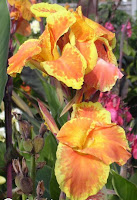The article then goes on to confuse Burbank’s own cultivars, whose writings and published photographs show and describe C. ‘Tarrytown ’ as being a large red flowered cultivar and C. ‘Burbank’ was yellow with some red spots in the throat. Up until then I was merely amused at the ignorance being attested to as fact.


At Claines Canna we are growing both C. ‘Tarrytown ’ and C’ ‘Burbank’, and they comply with Luther Burbank’s own descriptions and are Italian Group cultivars, see photo from Burbank's book, above. They arrived here from unimpeachable collector sources.
 Where I started to laugh was when the article asserted that Messrs J.C. Vaughan, the distinguished Chicago seeds men then renamed C. “
Where I started to laugh was when the article asserted that Messrs J.C. Vaughan, the distinguished Chicago seeds men then renamed C. “
A study of contemporary literature would clearly show that the lemon yellow with creamy-orange splotches and blobs being referred to is C. ‘Roma’, introduced by Carl Sprenger in 1897, above left. References include Revue Horticole in France, Garden and Forest in USA, and the Royal Horticultural Society Yearbook in England. The ultimate authorities of the time, and there are many more references from unimpeachable sources, versus this silliness on the TyTy web site!
The article also goes on to assert that the Italian Royal family, King Emmanuel II and his son, King Humbert were Canna hybridisers! There is not a shred of evidence to confirm this silliness.
Also, an English gardener, presumably hinting at the award winning gardening author Ian Cooke, renamed C. ‘Yellow King Humbert’ as C. ‘Richard Wallace’. C. 'Richard Wallace' is a Crozy Group cultivar introduced by Wilhelm Pfitzer in 1906, and what is now being sold under that name is C. ‘Austria
It is obvious that whoever wrote this article is very ill-informed! My suggestion would be that they take an elementary course in Canna flower types, when they would understand that there is more to Canna flowers than their colours.
There is an article on the Wikipedia that attempts to explain the various Canna types in a fully attested manner. Wikipedia does not allow statements or assertions without supporting references. See wikipedia.

Like you, I was amused and then somewhat horrified to read that ridiculous TyTy article.
ReplyDeleteThe rubbish about the Grand Opera Series of cannas (all of them Crozy types), being Italian Group cultivars just empahsises the man's complete ignorance on the names and history of cannas.
Next he'll be claiming to have raised new hybrids from seed obtained from the Italian Group cultivars who are all non seed setters!
It was obvious that the writer had done no serious research whatsoever. He does not even realise that hundreds of very fine Victorian era cannas are still thriving in cultivation.
It is beyond my ken how someone who claims to be a Canna authority would not know anything about the history of Canna hybridization. He cannot even distinguish between early Crozy cultivars, Victorian era ones and 20th century cultivars!
Hi Dale,
ReplyDeleteThe frightening thing is that hundred's of thousands of Americans will be taken in by this rubbish. The urban myth turns into fact after a few years.
How do we get the true facts across to the general gardening public?
Well, the correct information on so many cultivars is available on the internet thanks to your efforts. Unfortunately it doesn't seem to be getting to the right people. They obviously are not into researching anywhere, even the web which is at their fingertips.
ReplyDeleteThe tried and true method of disseminating correct botanical information still seems to be the publication of a hard copy book which finds its way to libraries all over the world.
Another monograph on the genus Canna is needed. Not much market out there for such a publication though, so it would be extemely difficult to find a publisher.
Meanwhile, we can just keep on nibbling away by publishing online as much info as we uncover with our researching.
Seems to me that the small-scale interest in Cannas means that probably no publisher would commit to another coffee-table book. But what about an Encyclopedia, which would attract the interest of Libraries and Botanical Institutions world-wide? Am I being over optimistic?
ReplyDeleteOtherwise, all that would be left is for somebody to produce an eBook and publish on the web.